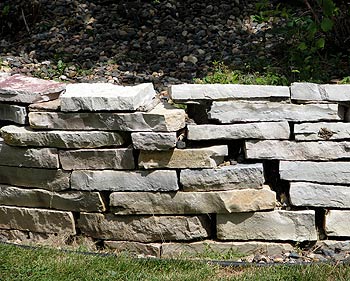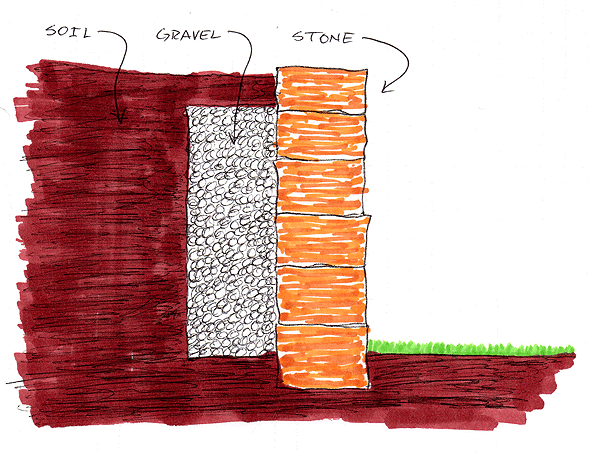RENEGADE GARDENER™
The lone voice of horticultural reason
Don’t build a wallstone retaining wall without backing drainage gravel.
 The wall pictured is in my neighborhood, it’s a homeowner job, and here’s why it’s coming apart after ten years: The homeowner backfilled the wall with soil, skipping the only mildly laborious step of backfilling the wall with an eight-inch-wide trough of 3/4 inch clear (meaning washed) gravel.
The wall pictured is in my neighborhood, it’s a homeowner job, and here’s why it’s coming apart after ten years: The homeowner backfilled the wall with soil, skipping the only mildly laborious step of backfilling the wall with an eight-inch-wide trough of 3/4 inch clear (meaning washed) gravel.
This is necessary not only here in true gardening country, Zone 4, where winter frost in soil causes stone to move, but should be a part of stone wall construction in warmer climes. Even in Zone 8, if you wish to construct a stone retaining wall taller than 24 inches, you really should install drainage gravel behind it. A heavy rain will turn soil to mud, and once soil turns liquid, its lateral push is remarkable. In Texas, for a wall this size, it might not wash out all at once, but it will slowly move, gaps will form, and in a decade or so it will resemble the wall pictured. You’ll enjoy hammering the stones back into place with a dead blow stone hammer for only so long. And eventually, they don’t go back in all the way.
Since this is the first full update of the off-season, I will spare no time and expense – here’s a sketch of what I’m talking about. What the hell, it’s a Saturday morning and I’m sitting at my computer in my underwear, I’ll even take time to color the thing:

Back to the photo, note that the wall pictured is made of quarried wallstone. For large boulders, a gravel drainage trough behind the wall is not necessary – only landscape fabric, to keep the backfill soil from flowing out the face of the wall. Boulders weighing 150 pounds or more are heavy enough to stay in place without drainage gravel, even in northern zones. Plus they usually involve a bit of a setback. But for boulder walls using small boulders, 12 inches or less, setback or no, if you get up around 24 inches high, you need to create a gravel drainage backing, because the small boulders don’t weigh enough to stay in place. They’ll move and collapse after repeated exposure to rain or irrigation, anywhere in the country.
Back to my sketch (original color sketch, signed by me, $120.00, e-mail), you don’t need landscape fabric vertically between the soil and the gravel, just place an eight-inch strip of fabric on top of the gravel trough before covering with four to six inches of soil (for planting sod or groundcovers).
Good place to plug my venerable stone book, I suppose, I wrote a book for Better Homes and Gardens/Meredith Publishing that gives you the complete how-to for all types of stone projects, you can check it out by clicking here.
Don Engebretson
The Renegade Gardener